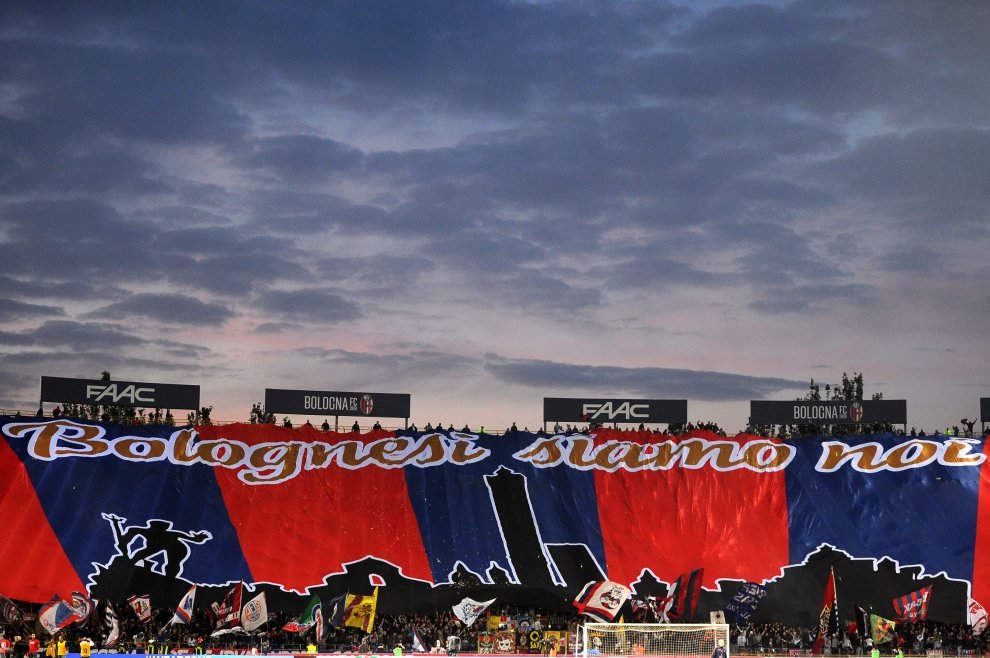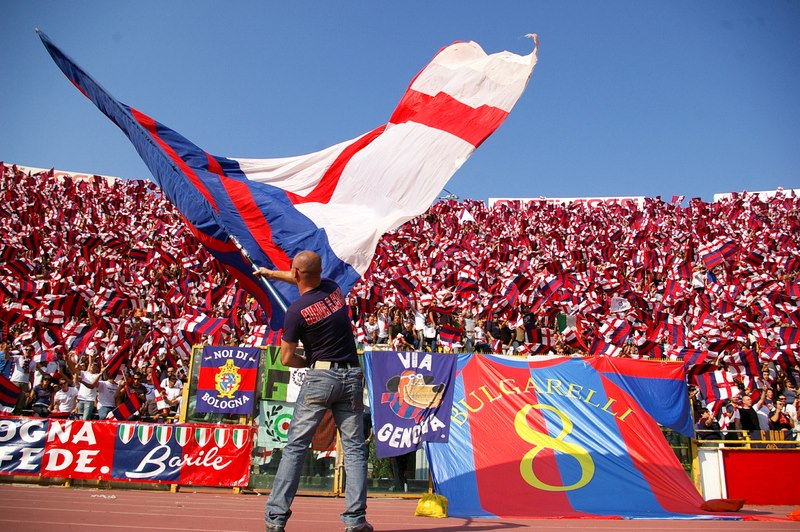Stadium: Stadio Renato Dall’Ara, capacity 38,297
The Stadio Renato Dall’Ara is a multi-purpose stadium that will be mostly remembered by English fans of Italian football due to an incident at Italia 90. England faced Belgium in the second round and were only minutes away from going into a penalty-shoot out before Paul Gascoigne floated in a free-kick for David Platt to volley home in spectacular fashion.
The ground itself has been renamed three times and used to be called both the Stadio Littoriale and the Stadio Comunale. It has a huge tower on one side and a roof over the other, features added when it was modified for the World Cup in 1990.
The atmosphere in the Stadio Renato Dall’Ara is always hostile even though it is generally only half-full. The Ultras on the the Curva Bulgarelli are passionate and very vocal. Flares, firecrackers and flags are often brought out by members of the Turist Group 1996, SGP 1999 and the more notorious Vecchia Guardia (Old Guard). These groups are some of the noisiest away fans in Italy and make even more effort when at home. The Derby of Appennino, against Fiorentina, is always a highlight. The match is a hard-fought affair and it shows the Stadio Renato Dall’Ara at its glorious best.
The Ultras
It’s the 2002-03 season and Bologna have travelled to the capital to face Roma. The home fans have choreographed a special display to welcome their rivals from Emilia Romagna. The Curva Sud is littered with placards that read “Bolognese amico della questura: spia spia spia” (“Bologna fans are friends of the police: spy spy spy”).Of course, the Bolognesi have their view of the Romanisti. “Se il mondo fosse una torta di merda, voi sareste la fetta piu grande!” (If the world was a cake of shit, you would be the biggest slice!”)
Believe it or not, Roma and Bologna used to be Gemellati (twinned). Friendly ties existed between two Ultra groups, the Mods of Bologna and the Boys of Roma. This was a friendship forged by Calcio as well as politics with both groups holding far-right ideologies.
In the 1995/96 season, Bologna were on the brink of promotion to Serie A. The Mods decided to invite their Roman allies to their decisive game against Chievo. Bologna won, but the joyous atmosphere was about to turn sour. Some of the Bologna and Roma Ultras took advantage of the chaotic celebrations and launched a racist attack on a group of north African drug dealers. Allegedly one man was stabbed. It is thought that to save their own skin a number of Bologna Ultras gave the police the names of the Roman perpetrators who were consequently arrested. The Bologna fans’ reputation was besmirched. For the Romanisti, the Bolognesi were no longer friends but the worst type of enemies,Infami, a term used in the criminal world for police informers.
It beggars belief that since the birth of Forever Ultras Bologna (URB) in 1974 the club has spawned 29 Ultra groups. It has at times been a story of factional infighting, a swirling morass of competing cliques vying for pre-eminence on the Curva Bulgarelli or Curva Nord. Both URB and the Mods (founded in 1982) have been two of the Rossoblu’s more famous groups. Occupying central positions of the Curva Bulgarelli (a sign of influence) they have been friendly neighbours, choreographing impressive match-day spectacles. This does not mean they have always seen eye to eye.
Following the racially aggravated assault, URB condemned the Mods and all involved. This falling out, coupled with pre-existent political divisions, made the relationship a fragile one. Despite the Mods and their extant sub-groups Molle Cariche (Loaded Springs) and Via Genova (Genoa Road) holding right-wing inclinations, Bologna’s Ultras are traditionally associated with leftist politics. This is historical. During the post-war years the city of Bologna became a stronghold for the Italian Communist Party. Groups like URB and Freak Boys, whose symbol is a marijuana leaf and whose motto “ovunque fattanza” (“always stoned”) became affiliated with the left. Indeed the URB emblem of two crossed hammers has strong resemblance to that of West Ham, though one of their leaders says it symbolises the left and the workers’ fight.
A scrupulous explanation of all the groups that remain would be laborious, but it is worth mentioning other Ultras who have been prominent on the Curva. These include Supporters (apolitical and formed in 1979), Bologna 1982, Vecchia Guardia (Old Guard), who were formed in 2001 and whose philosophy upholds the Ultra values of the older generation, and the recently formed Beata Gioventù (Carefree Youth) who replaced the Mods after they disbanded in 2012.
Bologna also has a women-only Ultras group known as URB Girls. The various groups, factions and alliances can be perplexing, however this phenomenon reflects wider Italian culture. Much like Bolognas’ Ultras, political parties in Italy form and disband, quarrel and mould friendships with dizzying frequency and rapidity. It is simply a way of living.
This is not to say the Ultras of Bologna do not unify when fighting a common cause. They do and they have a violent reputation. In 2005, following their Serie A relegation play-off defeat to Romagna rivals Parma, Bologna Ultras hurled metal bars and weights at police while they smashed through security barriers and tried to invade the pitch. The Curva Bulgarelli is also united in the fight against Calcio Moderno (the corruption of Italian football by corporate interests) and against Calciopoli (the match-fixing scandal of 2006 that implicated many of the country’s big clubs).
An incident involving clashes between Bologna and Fiorentina Ultras in 1989 saw a 14-year-old Bologna fan suffer third-degree burns after Viola Ultras launched a petrol bomb on to a train full of Bolognesi. This incident, combined with the geographical proximity of the two clubs, makes Fiorentina public enemy number one. Roma, Modena, Parma and many other clubs are not far behind. Bologna Ultras are said to have ties with Ravenna and German club Vfl Bochum, which are thought to be political.
Bologna is renowned for its medieval architecture, ancient university and fine cuisine. On match-days the Stadio Renato Dall’Ara only adds to the flavour, with the Curva Bulgarelli awash with red and blue accompanied by the colourful effects of various pyrotechnics reminiscent of the red rooftops of Bologna.
Classic player: Kennet Andersson
Most remembered for his spell at Bologna, Kennet Andersson may not be everyone’s first-choice forward when romanticising about Italian football in the late 1990s. Howver, the 6ft 4in Sweden striker could score goals in teams that were not always that successful and in turn proved to be a huge asset.Andersson was not new to football when he transferred to Bari in 1995 from Caen. He had already featured in the 1992 European Championships and has been Sweden’s top scorer at the 1994 World Cup, where they finished third. In the mid-1990s he decided to try his hand in the most competitive league in the world at the time, Serie A.In a notable first season with struggling Bari he managed to score nine goals. His team-mates Igor Protti, Nicola Ventola and countryman Klas Ingesson all helped to keep Bari in the division. His performances earned him a move to Bologna in 1996.
Andersson found his home in Bologna and in his three seasons there he helped them to a Coppa Italia semi-final, an Intertoto Cup and decent positions in Serie A (seventh, eighth and 11th). Although not prolific, his physicality and superb heading ability allowed him to score 26 goals in 86 appearances, and although often overshadowed by the likes of Igor Kolvyanov and Roberto Baggio, his contribution should not be ignored.
Andersson left Bologna in 1999 for a big yet ill-fated move to Lazio, where he featured only twice before returning to the club he loved in the same year. He scored seven times in 28 games for Bologna in his second spell with the club. His understated appeal persits in Bologna and, when Calcio ruled the world, Andersson was an unsung hero.


